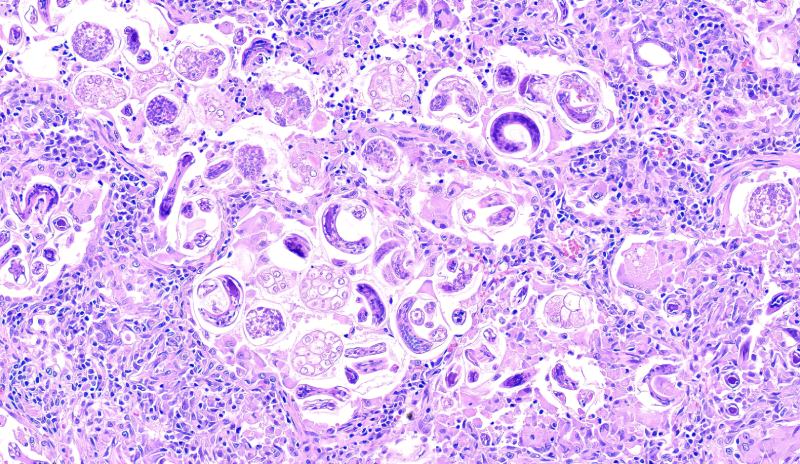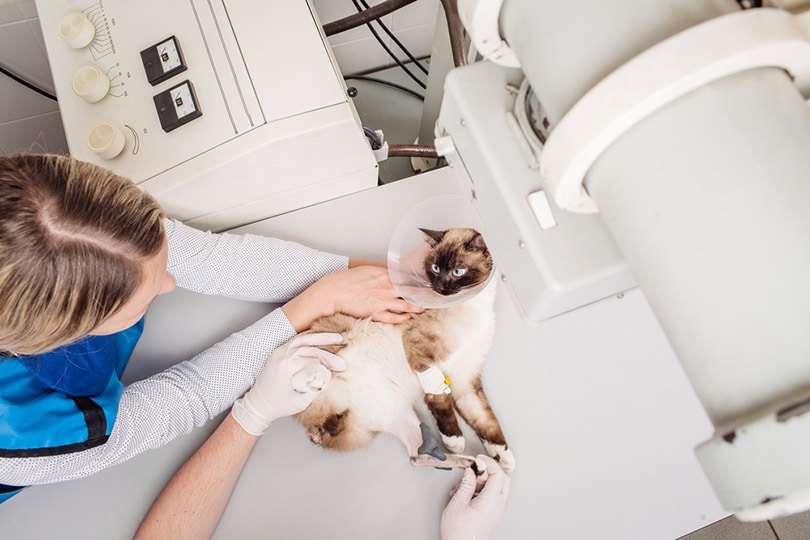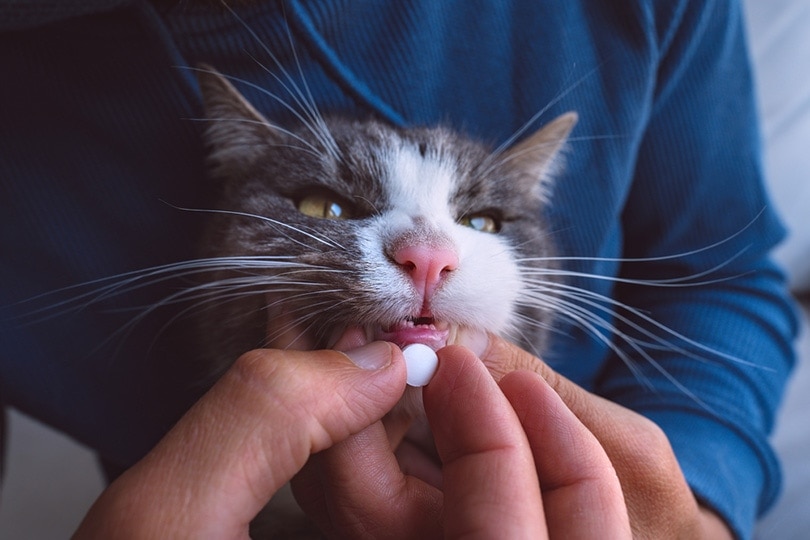Lungworm in Cats: Our Vet Explains Causes, Signs & Treatments

Updated on

Lungworms are worm parasites that can infest the respiratory tract of cats. They live and reproduce in the tissues of the respiratory system, causing damage to the tissues and airway and generating an inflammatory reaction. Several different parasites can infest the respiratory tract of felines, and Aelurostrongylus abstrusus is the most common.
These pulmonary parasitic infestations are most often found in cats that live outside, are free-roaming, or are strays. Cats become infested when they consume snails or slugs (intermediate hosts), cockroaches or frogs (paratenic hosts), reptiles, and small mammals or birds that are infested with lungworm larvae.
In this article, you will learn what lungworms are, the signs of lungworm infestation in cats, and its causes.
What Are Lungworms in Cats?
Lungworms are parasitic roundworms that can infest the respiratory tract of cats when they consume intermediate hosts, such as snails and slugs.1
The intermediate hosts become infested with these parasites when they consume their larvae (which can be eliminated through pets’ feces). They continue the rest of their lifecycle once they reach the digestive systems of cats and other animals.
In addition to the intermediate hosts, which are crucial for lungworms to survive and perpetuate the species, there are also paratenic hosts. 2 These are not necessary for the life cycle of lungworms but function as reservoirs for them. In paratenic hosts, lungworms cannot develop further. The paratenic hosts can be represented by earthworms, cockroaches, amphibians, reptiles, birds, and rodents.
The infective larvae (L3) are ingested by cats along with intermediate hosts,3 paratenic hosts, or other animals (rodents or birds). Once they reach a cat’s intestines, the larvae will transform into L4 and migrate to the lungs through the bloodstream (about a week after their ingestion). In a few days, they will become immature adults (L5) and reach the upper respiratory tract. In the lungs, the mature adult lungworms will reproduce and lay eggs containing the L1 larval stage. These eggs will be coughed up by cats and then swallowed, reaching their digestive tract. In this process, L1 transforms into L2 larvae, and infested cats will eliminate them in their feces. The intermediate hosts, paratenic hosts, and small mammals and birds will ingest the L2 larvae along with cats’ feces. The larvae will become infective L3 in a few days. Then, the life cycle continues.
What Are the Signs of Lungworms In Cats?
In most lungworm infestations, the clinical signs are absent, and the evolution of the disease is usually subacute or chronic. However, in massive infestations, cats can present the following clinical signs:
- Chronic, prolonged coughing
- Progressive dyspnea (difficulty breathing)
- Rapid breathing
- Runny nose
- Pale or blue mucous membranes
- Fatigue
- Lack of appetite
- Diarrhea
- Weight loss
- Enlarged lymph nodes
The more lungworms in your cat’s respiratory tract, the more noticeable the clinical signs will be. They will be more severe in old, young, and sick cats.
Chronic coughing—often suffocating—occurs due to the larvae in the respiratory tract and the increase in mucus secretion, which accumulates in the lungs. Untreated, this condition can lead to pulmonary emphysema (pathological damage of the lungs), pulmonary edema (fluid in the lungs), or pneumonia. The clinical signs of these problems include difficulty breathing (dyspnea) and increased breathing rate (polypnea). You can observe abnormal breathing in your cat if they have an open mouth and exaggerated abdominal movements.
Cats can also repeatedly sneeze and have an increased heart rate (tachycardia). They will present with fatigue at low or medium effort and generally have a bad physical condition. They will be lethargic and have no appetite. Sometimes, cats present with diarrhea and weight loss. The nasal discharge in the initial phase is abundant, seromucous, and sometimes pink, while in the advanced stages, it becomes purulent.
Muscle wasting and accumulation of fluid in the chest cavity (hydrothorax) can also occur. If the condition is left untreated, cats can die.
How Are Lungworms Diagnosed in Cats?
Diagnostic tests are necessary for this condition because the clinical signs of lungworm infestation in cats are similar to those of other diseases. Since the most noticeable clinical sign is coughing, the differential diagnosis will be made for:
- Asthma
- Bronchitis
- Pneumonia
- Pulmonary granulomatosis
- Allergies
- Foreign body
- Cancer
- Respiratory infections
- Heartworms
- Heart disease
- Your cat’s medical history
- The general exam, which will include the auscultation of the lungs and heart
- Chest X-rays: This is to rule out other causes of coughing (e.g., cancer, infections). Certain lungworm infestations lead to characteristic or suggestive lung changes.
- Coproparasitological examination: This highlights whether there are lungworm eggs or larvae in your cat’s feces.
- Heartworm test: This condition has coughing as its main clinical sign, so it’s necessary to rule it out.
- Transtracheal aspirates, tracheal swabs, or bronchoalveolar lavage fluid and microscopic examination of the collected sample: This examination is the only way to highlight the presence of parasites in the respiratory tract of cats.
- Blood count: This highlights the signs of infestation and eosinophilia (increased number of eosinophils, caused by the presence of parasites).
- Blood biochemistry: The parameters should be within normal limits in the case of lung parasite infestations.
- Feline leukemia (FeLV) or feline immunodeficiency (FIV) tests
- Cardiac ultrasound, to rule out heart diseases

What Are the Causes of Lungworms in Cats?
The causes of lungworm infestation in cats are mainly represented by the ingestion of intermediate hosts (snails and slugs) but also of paratenic hosts (frogs, cockroaches, birds, or rodents). Sometimes, cats can become infested if they drink contaminated water, but it typically occurs after ingesting birds and small mammals with infecting larvae. Regarding the predisposition to infestation, free-roaming cats are the most affected.
- Aelurostrongylus abstrusus (the most widespread, and the parasitosis occurs most often along the southeastern United States)
- Capillaria aerophila (Eucoleus aerophilus)
- Troglostrongylus brevoir
How Do I Care for a Cat With Lungworms?
Most of the time, lungworm infestation is asymptomatic. That said, if your cat has chronic coughing, runny nose, diarrhea, or difficulty breathing, take them to the veterinarian. Once the diagnosis is established, the vet will prescribe a treatment, which usually includes the administration of antiparasitic medication (liquids or pills). In severe cases, the veterinarian can administer supportive treatment. In addition to the treatment, you will be advised to monitor your cat carefully at home.
The remission of your cat’s disease will be verified by chest X-rays and coproparasitological examination performed 2–4 weeks after the start of treatment.
If the condition is left untreated for a long time, permanent scarring can form in your cat’s lungs, and your pet will be left with a persistent cough.
To minimize the chances of reinfestation, you must not let your cat consume intermediate and paratenic hosts or drink contaminated water. This is the only way to prevent your cat from becoming reinfested with lungworms.

Frequently Asked Questions (FAQ)
How Serious Is Lungworm in Cats?
Adult cats usually experience mild clinical signs. Severe signs occur more often in young, old, or immune-compromised and sick cats. The prognosis of the condition is most often favorable, but if left untreated, permanent scarring can result in your cat’s lungs. In severe cases, cats can develop respiratory failure and die.
What Do Lungworms Look Like in Cats?
Lungworms are thread-shaped roundworms of lengths between 5 mm and 30 mm, depending on the species. Several species of lungworms can infest cats, though Aelurostrongylus abstrusus is the most common. Usually, these parasites are seen at necropsy or after bronchoalveolar lavage.
Do Lungworms Come Out in Poo?
The larval stage L2 comes out in cats’ poo. Once your cat ingests the infecting larvae (along with the intermediate hosts), they reach the digestive tract, where they will migrate from the intestine to the respiratory tract through the bloodstream. After reaching the respiratory tract, they will migrate to the lungs, where they will become adults. Adults will mate and lay eggs that contain the first larval stage. Cats will cough up eggs with larvae, which they will then swallow, reaching the digestive tract. The second larval stage will then be eliminated through feces in the environment, and the biological cycle continues.

Conclusion
Lungworms can infest the respiratory tract of cats. These worms damage the airways and/or lung tissue and cause an inflammatory reaction. Several species of lungworms can parasitize cats, with Aelurostrongylus abstrusus being the most common. The clinical signs of massive infestations include chronic coughing, sneezing, runny nose, breathing difficulties, diarrhea, lethargy, etc. In severe cases, lungworms can lead to pneumonia and respiratory failure, which can be fatal. When you notice the clinical signs, take your cat to the veterinarian for diagnosis and treatment. The condition is treatable and the prognosis is most often favorable.
- Related Read: Botflies in Cats: Vet-Reviewed Causes, Signs & Treatment
Featured Image Credit: HappySloth, Shutterstock












